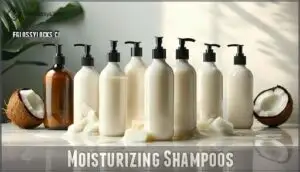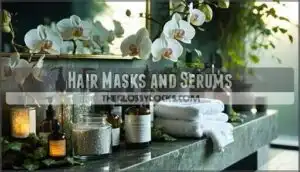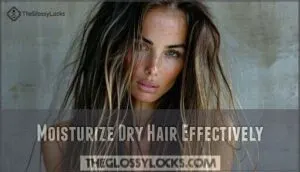This site is supported by our readers. We may earn a commission, at no cost to you, if you purchase through links.

Start by swapping harsh shampoos for sulfate-free formulas, and never skip conditioner.
Deep conditioning masks once weekly work wonders, while leave-in treatments provide daily protection.
You’ll want to ditch the towel-drying habit that’s roughing up your cuticles – gently squeeze water out instead.
Heat styling tools are the enemy here, so embrace air-drying when possible.
Natural oils like argan or coconut can seal in hydration between washes.
Think of your hair care routine as feeding a thirsty plant – consistency matters more than expensive products.
Table Of Contents
- Key Takeaways
- Causes of Dry Hair
- Hydrate Dry Brittle Hair
- Choose Right Hair Products
- Protect Hair From Damage
- Moisturize Dry Hair Effectively
- Maintain Healthy Hair Habits
- Frequently Asked Questions (FAQs)
- How do you hydrate brittle hair?
- How to hydrate hair?
- What can I do if my hair is brittle?
- What causes dry brittle hair?
- How to rehydrate dry hair?
- Can dry brittle hair turn into a bad day?
- How do you fix super dry brittle hair?
- How do you rehydrate dry hair?
- Can dry brittle hair be restored?
- How do you bring dry brittle hair back to life?
- Conclusion
Key Takeaways
- Switch to sulfate-free shampoos and deep condition weekly – You’ll preserve your hair’s natural oils while replenishing moisture with treatments containing coconut oil, argan oil, or shea butter that penetrate the hair shaft.
- Ditch heat styling tools and embrace air-drying – You’re causing significant damage when you use tools above 300°F, so limit heat styling to once weekly and use heat protectants when you can’t avoid it.
- Change how you handle wet hair and rinse with cool water – You’ll prevent breakage by gently squeezing out water instead of towel-drying, and cool water seals your cuticles to lock in moisture.
- Focus on nutrition and consistent care habits – You need adequate protein, omega-3s, and vitamins for healthy hair growth, plus regular trims every 6-8 weeks to prevent split ends from traveling up your hair shaft.
Causes of Dry Hair
Understanding what’s making your hair dry and brittle is the first step toward fixing the problem.
Your hair faces daily challenges from heat styling tools, environmental factors like sun and wind, harsh chemical treatments, and even your washing habits that strip away natural oils.
Environmental Factors
When your hair battles environmental elements daily, it’s fighting an uphill battle for moisture.
Your hair’s daily environmental battle leaves it thirsting for the moisture it desperately needs to survive and thrive.
Climate impact from dry air strips natural oils, while pollution effects create a barrier that blocks hydration.
Seasonal changes between hot summers and cold winters shock your strands, and UV damage breaks down proteins.
Hard water leaves mineral buildup that prevents proper hair hydration methods from working effectively.
Heat Styling Tools
Your favorite styling tools might be sabotaging your dry hair hydration efforts.
Heat styling tools operating above 450°F cause significant damage to your hair’s protective cuticle, leading to moisture loss and increased brittleness.
- Temperature Control: Keep tools below 300°F and use heat protectants before every styling session
- Tool Material: Choose ceramic or tourmaline tools that distribute heat more evenly than metal alternatives
- Styling Frequency: Limit heat styling to once weekly, embracing alternative methods like braiding or air-drying for brittle hair repair
Harsh Chemical Treatments
Chemical salon treatments wreak havoc on your hair’s moisture barrier.
Relaxer damage weakens protein bonds, while perm effects create lasting dryness.
Color stripping and bleach risks remove natural oils, leaving strands parched and prone to breakage.
These processes compromise your hair’s ability to retain moisture.
Consider treatment alternatives like semi-permanent dyes or gentler formulations to minimize chemical damage and preserve hydration, and think about the importance of moisture barrier protection.
Nutrient Deficiencies
Your body’s nutritional bank account directly affects your hair’s health. When you’re running low on essential nutrients, your strands become the first casualty, turning dry and brittle.
Your hair is your body’s financial report card – when nutrients run low, your strands pay the price first.
Key nutritional deficiencies that cause hair breakage include:
- Iron deficiency – the world’s most common cause of hair loss and brittleness
- Vitamin D and biotin shortages – leading to weakened hair structure and thinning
- Essential minerals like zinc and selenium – supporting protein synthesis for strong strands
- B-complex vitamins – maintaining healthy growth cycles and preventing premature graying
Poor mineral absorption prevents your hair from getting the building blocks it needs, while inadequate protein intake and omega-3 sources leave your strands undernourished. Even mild vitamin deficiencies can trigger noticeable changes in hair texture. A deficiency in vital nutrients, such as vitamin D deficiency, can lead to excessive shedding. The hydration impact of nutritional deficiencies creates a domino effect, where your hair loses its natural moisture-retention abilities, making it more susceptible to environmental damage and styling stress.
Aging and Hormonal Imbalances
As you age, your body’s sebum production naturally decreases, leaving hair drier and more brittle.
Menopause effects and other hormonal imbalances can accelerate hair thinning and moisture loss.
Hormone replacement therapy and dietary adjustments may help restore hair hydration, but understanding these changes helps you adapt your hair care routine accordingly.
| Life Stage | Hormonal Changes | Hair Impact |
|---|---|---|
| Pre-menopause | Gradual estrogen decline | Reduced sebum production |
| Menopause | Significant hormone drops | Increased hair thinning |
| Post-menopause | Low estrogen levels | Persistent dryness issues |
Hydrate Dry Brittle Hair
When your hair feels like straw, it’s crying out for hydration, and you can answer that call with targeted treatments that actually work. Dry hair treatment starts with understanding that moisture retention is key to transforming brittle strands into healthy, supple locks.
Here are three proven hair hydration methods to restore your hair’s natural vitality:
- Overnight Masks: Apply coconut oil or argan oil from mid-length to ends before bed, covering with silk scarves to prevent pillow absorption and maximize penetration.
- DIY Sprays: Mix distilled water with glycerin (a powerful humectant) for daily moisture boosts that don’t weigh hair down.
- Scalp Massage: Stimulate circulation with gentle fingertip pressure while applying nourishing oils, promoting natural sebum distribution.
These dry hair remedies work because they address moisture at the cellular level. Understanding hair porosity matters when selecting the right hydrating treatments. Humectant benefits include drawing moisture from the environment directly into your hair shaft, creating lasting hydration that transforms your hair’s texture and appearance.
Choose Right Hair Products
You can’t fix dry, brittle hair without the right products working alongside your efforts.
The shampoos, conditioners, and treatments you choose will either restore your hair’s moisture or continue stripping it away, so selecting formulas with hydrating ingredients like coconut oil, shea butter, and natural oils makes all the difference.
Moisturizing Shampoos
When selecting the right hydrating shampoo, you’ll want to look for creamy textures that signal moisturizing properties.
These formulas contain nourishing ingredients like coconut oil and shea butter that hydrate dry hair without stripping natural oils.
Consider sulfate alternatives for gentler cleansing, and adjust your shampoo frequency based on your specific hair type’s needs.
Many consumers find success using Shea Moisture products for hydration.
| Hair Type | Recommended Frequency | Key Ingredients |
|---|---|---|
| Fine/Oily | Every other day | Lightweight oils, proteins |
| Normal/Combination | 2-3 times per week | Coconut oil, jojoba oil |
| Thick/Dry | 1-2 times per week | Shea butter, argan oil |
Leave-in Conditioners
After choosing the right moisturizing shampoo, you’ll want to lock in that hydration with a quality leave-in conditioner.
These products work differently than rinse-out versions, staying on your strands to provide ongoing protection.
Spray formulas work best for fine hair types, while cream varieties suit thick, brittle hair.
Many users find benefits in a daily spray application.
Application techniques matter – focus on mid-lengths and ends for maximum hair moisturizing benefits.
Hair Masks and Serums
Beyond basic conditioners, hair masks and serums deliver intensive hydration your strands desperately need.
These concentrated treatments penetrate deeper than regular products, restoring moisture and repairing damage from heat styling and environmental stress.
For intense hydration, consider using specialized hair products.
Your deep conditioning hair routine should include:
- Weekly protein vs moisture masks – alternate between strengthening and hydrating treatments
- Overnight hair masks – let DIY treatments work while you sleep
- Daily serum application tips – apply to damp hair for maximum absorption
Natural Oils and Ingredients
Natural oils become your hair’s best friends when store-bought treatments fall short.
Coconut oil penetrates deeply, delivering superior moisturizing benefits that restore damaged strands. Argan oil seals moisture while aloe hydration repairs UV damage naturally.
Essential oils like peppermint and lavender enhance these treatments when mixed with carrier oils. Honey masks provide gentle conditioning for ultimate natural hair hydration.
Some oils, like tea tree, stimulate hair growth and maintain scalp health.
Protect Hair From Damage
Prevention works better than trying to repair damage after it’s already happened to your hair.
You’ll save time, money, and frustration by taking simple steps to shield your strands from heat styling tools, harsh sun exposure, and chemical treatments that strip away natural moisture.
Reduce Heat Styling
Heat styling wreaks havoc on brittle hair, causing serious hair breakage solutions to become necessary.
Embrace air dry benefits whenever possible, letting your hair’s natural texture shine.
When you must use heated tools, apply heat protectants first and choose lower temperatures below 300°F.
Invest in quality styling tools with ceramic or tourmaline plates.
Explore styling alternatives like braiding damp hair for waves, reducing your reliance on damaging heat while promoting healthier hair drying methods.
Minimize Sun Exposure
Your hair faces daily assault from UV rays, which break down proteins and strip moisture like a relentless desert sun.
UV protection becomes your hair’s best friend when you step outside.
Here are five ways to shield your strands from harmful sun exposure:
- Wear wide-brimmed hats during peak sun hours (10 AM to 4 PM) for maximum hair environmental protection
- Apply UV-protective sunscreen sprays specifically formulated for hair before outdoor activities
- Choose protective styles like braids or buns that minimize direct UV contact with your hair shaft
- Seek shade whenever possible to reduce cumulative hair sun exposure and prevent long-term damage
- Use leave-in products with built-in UV filters for continuous hair damage prevention throughout the day
Avoid Harsh Chemical Treatments
Chemical treatments like bleaching, perming, and relaxing strip your hair’s natural moisture, leaving strands vulnerable to breakage.
Relaxer damage often creates irreversible brittleness that’s tough to repair.
Consider treatment alternatives such as natural dyes or gentle perms that won’t compromise your hair’s integrity, and use these damaged hair repair strategies to help strengthen hair while minimizing future brittle hair treatment needs.
Moisturize Dry Hair Effectively
You’ll need a systematic approach to restore moisture to parched strands, focusing on products and techniques that penetrate the hair shaft rather than just coating the surface.
This section covers four essential methods that work together to rebuild your hair’s moisture barrier, from choosing the right cleansing formulas to sealing in hydration with targeted treatments, which helps to rebuild your hair’s natural hydration.
Use Moisturizing Shampoo
Switch to sulfate-free options that won’t strip your hair’s natural oils.
Look for hydrating formulas with a creamy texture containing coconut oil, jojoba, or shea butter – these shampoo ingredients signal genuine moisturizing power.
Apply the product gently to wet hair, focusing on your scalp rather than lengths, to transform dry, brittle hair into manageable, healthier strands with hydrating formulas and natural oils.
Apply Hair Masks
Deep conditioning treatments become your hair’s best friend when dryness takes over.
Apply moisturizing hair mask from mid-length to ends weekly, focusing on the most damaged areas.
DIY masks using natural mask ingredients like honey or avocado work wonderfully.
Leave treatments on for 15-30 minutes under a shower cap.
These mask benefits include restored moisture and improved texture in your hair hydration routine.
Rinse With Cool Water
After applying your hair mask, complete your hair hydration routine with a cool water rinse.
This simple step helps seal cuticle layers, locking in moisture while reducing frizz.
Cool water also enhances shine and improves manageability by smoothing the hair shaft.
Your scalp benefits too, as cooler temperatures won’t strip away natural oils like hot water does.
Consider also using mild sulfate-free shampoos to further protect your hair and improve its overall manageability.
Apply Serum and Leave-in Conditioner
After your cool water rinse, lock in that moisture with a strategic one-two punch.
Apply hair serum first, focusing on mid-lengths and ends where dryness hits hardest, and follow with leave-in conditioner for double protection.
Choose lightweight serums for fine hair or richer formulas for thick strands, as this product layering technique creates a moisture barrier that keeps your hair hydration routine working all day long.
Maintain Healthy Hair Habits
Building healthy hair habits creates the foundation for long-term hydration and prevents future damage from occurring.
You’ll need to establish consistent routines that protect your hair’s natural moisture while supporting overall hair health through proper nutrition, gentle handling, and regular maintenance.
Trim Split Ends Regularly
When split ends climb up your hair shaft like unwelcome visitors, they steal moisture and create more breakage.
You’ll need sharp hairdressing scissors—never regular scissors—for proper trimming techniques.
Cut quarter-inch above the split to prevent further damage.
Regular trimming every six weeks removes damaged ends, allowing healthy hair growth while maintaining your dry hair moisturizing routine’s effectiveness, which is crucial for preventing more breakage.
Use Gentle Hair Care Techniques
Small changes in your daily routine can dramatically reduce hair breakage and preserve moisture.
Skip wet hair brushing since damp strands are fragile and prone to snapping. Instead, use a natural bristle brush on dry hair to distribute oils evenly.
Reduce washing frequency to maintain natural sebum, and finish with a cool water rinse.
Silk pillowcases prevent overnight moisture loss.
Stay Hydrated and Eat Nutritious Foods
True beauty starts from within, and your hair reflects what you feed your body.
Dietary hydration and vitamin intake create the foundation for healthy strands, while omega-3 sources provide essential fatty acids your hair craves.
Focus on these protein power essentials:
- Marine proteins like salmon deliver shine-boosting nutrients
- Antioxidant benefits from blueberries combat hair damage
- Daily water intake maintains natural hair hydration pack
Reduce Stress and Get Enough Sleep
High levels of chronic stress and sleep deprivation create a perfect storm for dry, brittle hair through hormonal disruption.
Your scalp health suffers when cortisol levels spike, reducing natural oil production and weakening hair follicles.
Prioritizing seven to nine hours of quality sleep supports overall wellness and provides essential hair hydration benefits that commercial hair moisturizing tips can’t replicate alone.
| Stress Level | Sleep Quality | Hair Impact |
|---|---|---|
| High chronic stress | Less than 6 hours | Severe hair breakage, thinning |
| Moderate daily stress | 6-7 hours interrupted | Increased dryness, less shine |
| Low stress levels | 7-8 hours quality | Improved scalp circulation |
| Well-managed stress | 8-9 hours deep sleep | Strong, hydrated strands |
| Stress-free periods | Consistent sleep schedule | Ideal hair growth cycle |
Frequently Asked Questions (FAQs)
How do you hydrate brittle hair?
You’ll need deep conditioning treatments weekly, gentle shampoos with natural oils, and leave-in conditioners.
Limit heat styling, use cool water rinses, and apply coconut or argan oil to seal moisture into damaged strands effectively.
How to hydrate hair?
Your hair’s thirsting for moisture like a desert craves rain.
Deep condition weekly, use leave-in treatments, and wash less frequently with sulfate-free shampoos.
Seal with natural oils like argan or coconut for lasting hydration.
What can I do if my hair is brittle?
Trim split ends every 6-8 weeks to prevent further damage.
Deep condition weekly with coconut oil or argan oil masks.
Reduce heat styling, use cool water rinses, and switch to sulfate-free shampoos that won’t strip natural oils.
What causes dry brittle hair?
Like parched earth cracking under relentless sun, your hair suffers from heat styling, overwashing, chemical treatments, and environmental damage.
UV rays, harsh weather, aging, and nutrient deficiencies strip away moisture, leaving strands brittle and lifeless.
How to rehydrate dry hair?
Start with weekly deep conditioning treatments using coconut oil or argan oil masks.
Reduce washing frequency, use lukewarm water, and apply leave-in conditioner to damp hair.
You’ll see smoother, more manageable strands within weeks, with argan oil masks being a great option.
Can dry brittle hair turn into a bad day?
When you’re having a bad hair day, dry brittle strands can definitely throw a wrench in your plans.
You’ll struggle with styling, face increased breakage, and feel less confident about your appearance throughout the day, which can be summarized as having a bad hair day.
How do you fix super dry brittle hair?
You’ll want to deep condition weekly, reduce heat styling, use moisturizing shampoos with natural oils, and apply leave-in treatments.
Regular trims every six weeks remove damaged ends and prevent further breakage, which can be considered a complete concept in hair care.
How do you rehydrate dry hair?
Deep condition weekly with coconut oil or argan oil masks.
Use moisturizing shampoos less frequently, apply leave-in conditioner on damp hair, and rinse with cool water to seal cuticles and lock in hydration.
Can dry brittle hair be restored?
Yes, you can restore dry brittle hair with consistent care.
Regular deep conditioning, trimming split ends, reducing heat styling, and using moisturizing products will gradually improve your hair’s health and appearance.
How do you bring dry brittle hair back to life?
Start with deep conditioning treatments weekly, trim split ends regularly, reduce heat styling, and use moisturizing shampoos with natural oils.
You’ll gradually restore moisture, strength, and shine to your damaged strands.
Conclusion
Surprisingly, damaged hair can lose up to 40% of its moisture within hours of washing.
Transform your dry, brittle strands by implementing these proven strategies consistently. Remember, learning how to hydrate dry brittle hair requires patience and dedication to proper techniques.
Your hair didn’t become damaged overnight, so healing takes time. Start with sulfate-free products, embrace gentle drying methods, and nourish your strands with regular deep conditioning treatments.
Healthy, hydrated hair is absolutely achievable with the right approach.













